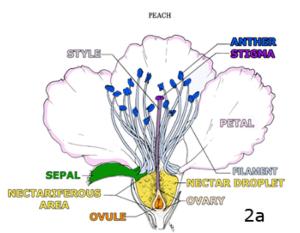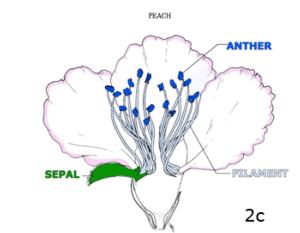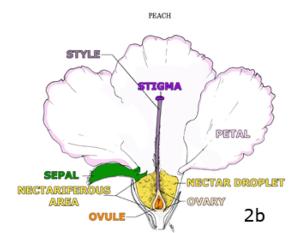Flower Anatomy
Reproductive Structures in a Flower
Flower Anatomy & Pollination > Flower Anatomy
Biologists frequently use dissections to study internal organs of animals. Dissections can also be used to view the structure and development of plant organs. For example, plant biologists commonly use longitudinal sections to reveal the reproductive structures contained within a flower. A longitudinal section is a form of dissection which cuts the flower lengthwise from the tips of the petals down to the stem (Figure 1).
The majority of flowering plants have “perfect” flowers which contain both male and female reproductive structures (Figure 2a), although some species produce “imperfect” flowers with only female (Figure 2b) or male (Figure 2c) structures.




Most Plants are Hermaphrodites
The majority of tree fruit and nut crops grown in California have perfect flowers which contain both male and female reproductive structures within each flower (Summary Table, Figure 2a). A plant species with both female and male reproductive structures on the same individual is monoecious. Monoecious plant species can have either perfect flowers (Figure 3a), or male and female imperfect flowers on the same individual (Figure 3b).
All fruit and nut crops in the genus Prunus (almond, apricot, cherry, nectarine, peach, plum and prune) are monoecious with perfect flowers. Walnut and chestnut are monoecious with imperfect male and female flowers on the same tree (see Summary Table). In contrast, a plant species with female and male reproductive structures on separate individuals is dioecious (Figure 3c). Common dioecious crops include pistachio, persimmon, and kiwifruit (see Summary Table).
In each flower in the trees below, female structures are shown in red and male structures are shown in blue.

How do orchard establishment practices differ between monoecious & dioecious species?
Pollination, the movement of pollen from anthers to stigma, is required for seed and fruit development in almost all fruit and nut crops.
The distance between male and female reproductive structures determines the distance pollen must travel to intercept a stigma of the same species. As the distance between anthers and stigma increases, the likelihood that an individual pollen grain will successfully fertilize an ovule decreases. The minimum distance pollen must travel between male and female structures varies substantially among monoecious species with perfect flowers, monoecious species with imperfect flowers, and dioecious species (Figure 4).
The types of flowers in a fruit or nut crop species influences the ideal spacing when planting an orchard and the ratio of male to female trees required for adequate pollination and fruit set.
In the trees below, red arrows depict the minimum distance pollen must move to intercept receptive stigma.

Study tip: “Mono-” means one in latin and “- ecious” means house. A “monoecious” plant species has both sexes in one “house”, or individual. “Di-” means two in latin. A “dioecious” plant species has both sexes split across two “houses”, or individuals.
